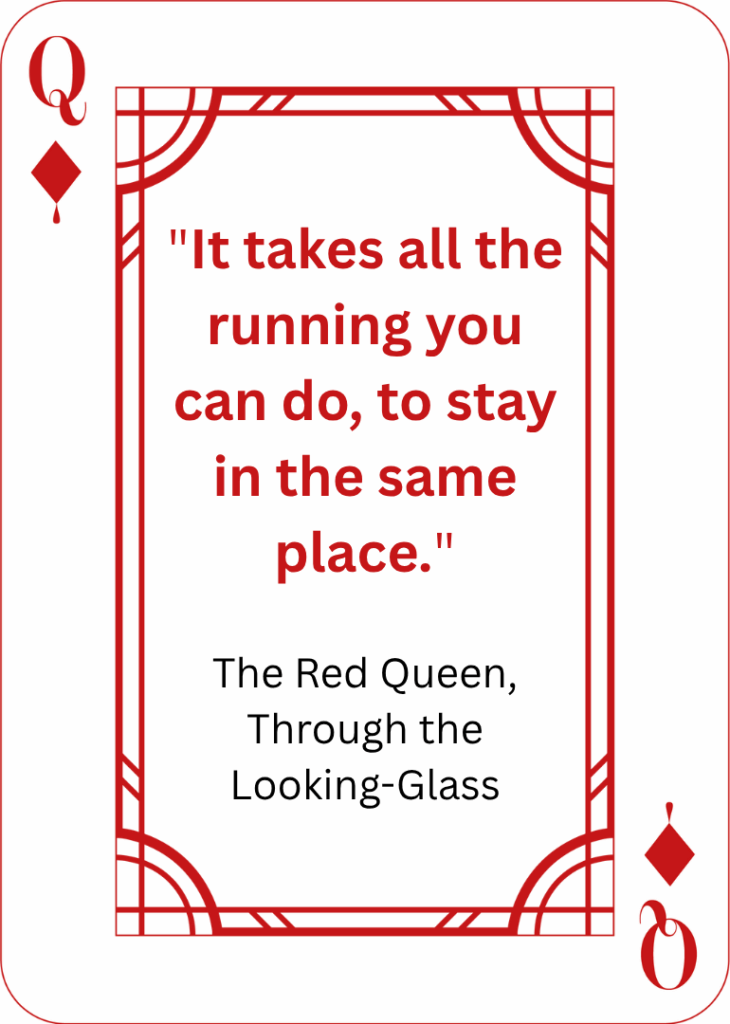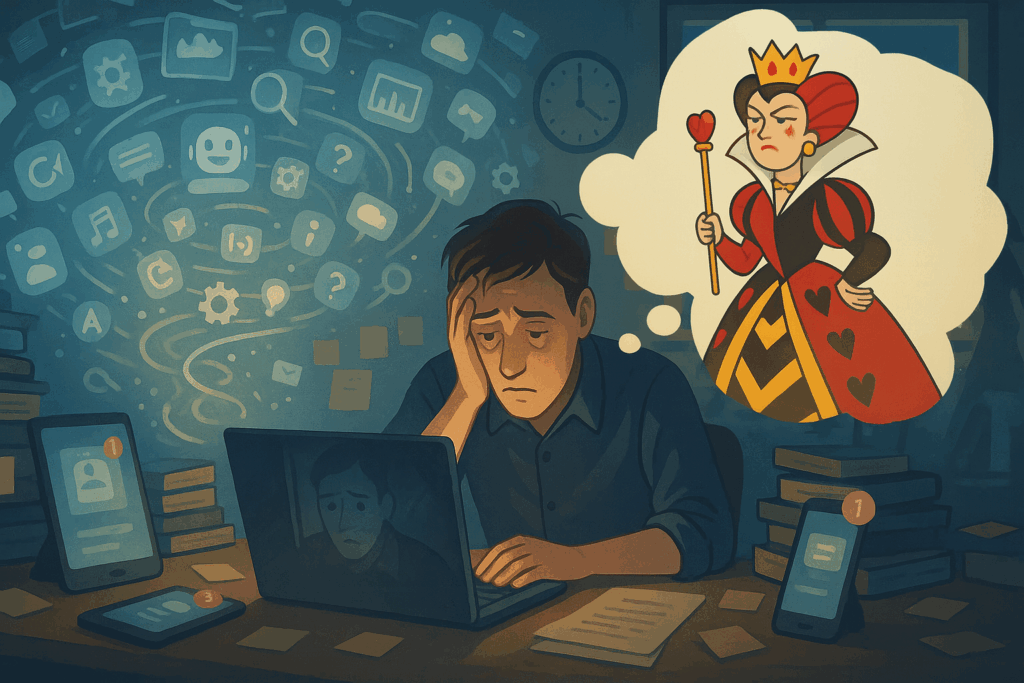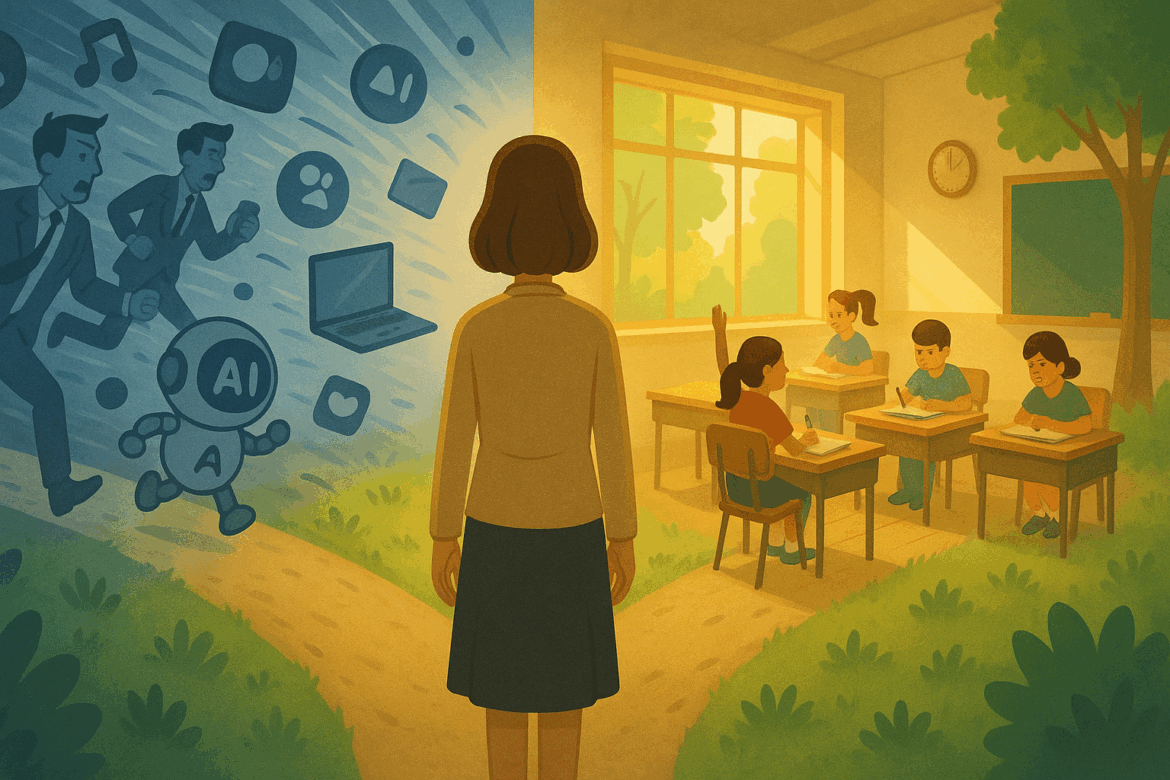The Exhausting Sprint That Goes Nowhere
Picture this: You arrive at school Monday morning and find three emails about new AI tools “every teacher should be using.” Your colleague mentions a ChatGPT lesson plan hack in the hallway. During lunch, you scroll through education Twitter and see teachers celebrating their latest classroom innovation. By the time you head home, you feel simultaneously behind and overwhelmed.
Welcome to the Red Queen Race in education.

This concept, borrowed from Lewis Carroll’s whimsical tale, has found new relevance in our AI-accelerated world. The original metaphor described how Alice and the Red Queen had to run as fast as they could just to stay in the same place—and this perfectly captures what’s happening across industries today – including education. Before you even check your morning messages, headlines about new AI breakthroughs have already moved the goalposts. A late-night announcement about an educational AI tool becomes breakfast conversation, and by lunch, not knowing about it feels like falling behind. Just like Alice and the Red Queen, many teachers find themselves sprinting to keep up with technological advances while feeling they’re falling further behind, caught in a cycle where yesterday’s innovation becomes today’s baseline expectation.
But here’s the thing: you don’t have to run this race.
To be clear, this isn’t about rejecting AI or technology entirely. It’s about finding sustainable technology and utilizing it in smart ways.
When AI tools genuinely improve efficiency, boost productivity, or provide valuable insights into student learning, they’re worth adopting. The problem isn’t with technology itself—it’s with the frantic pressure to adopt every new tool simply because it’s the newest thing on the block. Strategic integration based on actual classroom needs is very different from trend-chasing driven by fear of falling behind.
Recognizing When You’re Caught in the Race

The educational Red Queen Race has some telltale signs:
Sunday Night Anxiety: That sinking feeling that you’re not tech-savvy enough for the week ahead. You’ve bookmarked seventeen articles about AI in education but haven’t had time to read any of them.
Tool Fatigue: Your digital toolkit has become a graveyard of half-learned platforms. You signed up for the webinar, downloaded the app, but never quite mastered any of them before the next “game-changing” tool appeared.
Comparison Overwhelm: Watching colleagues effortlessly integrate the latest technology while you’re still figuring out last month’s innovation. Their highlight reels make your behind-the-scenes struggles feel inadequate.
Diminishing Returns: You’re spending more time learning about educational technology than actually benefiting from it. The tools promise to save time, but the learning curve keeps eating into your evenings and weekends.
Why Teachers Should Step Off the Treadmill
Your Core Skills Matter More Than Your App Collection
The best teachers throughout history shared certain qualities: they built relationships, inspired curiosity, and helped students think critically. None of these essential skills require the latest AI platform. While technology can enhance these abilities, it cannot replace them.
Here’s a fundamental truth: if you ever have to choose between good pedagogy and eye-catching technology, choose good pedagogy every time. The technology will change—and change again, and again. But solid teaching principles endure because they’re rooted in how students actually learn and grow.
Students remember teachers who saw them, challenged them, and believed in them—not teachers who used the newest software.
Sustainable Innovation Beats Frantic Adoption
Research consistently shows that successful technology integration happens slowly and thoughtfully. Schools that mandate rapid adoption often see higher teacher burnout and lower student engagement. The most effective educational technology implementations involve careful planning, adequate training, and gradual rollout.
Quality trumps quantity every time.
Your Wellbeing Affects Your Effectiveness
Teacher burnout is at historic highs, and the pressure to constantly upskill contributes significantly to this crisis. When you’re exhausted from chasing the latest trends, you have less energy for the human connections that make teaching magical.
Taking care of yourself isn’t selfish—it’s essential for taking care of your students.
Practical Strategies for Avoiding the Race
1. Embrace the “Minimum Effective Dose”
Instead of trying to master every educational technology tool, identify the smallest set of versatile tools that give you the biggest impact. This might be:
- One AI writing assistant
- One presentation tool you know well
- One collaborative platform your students actually use
- One assessment tool that truly saves you time
Master these deeply rather than dabbling in dozens.
2. Create Technology-Free Zones
Deliberately design lessons and activities that don’t require any technology. This serves multiple purposes:
- Protects proven teaching methods that work
- Gives you and your students a break from screen fatigue
- Reminds everyone that learning happened for centuries without WiFi
- Builds your confidence in your core teaching abilities
3. Implement Collaborative Filtering
Form a small “tech team” with trusted colleagues. This could even be incorporated into existing PLC meetings when you’re intentionally focusing on tech tools that support your content, engage students, and/or provide quality assessment strategies and data. Divide and conquer:
- Each person investigates one or two new tools per month
- Share honest reviews (including failures) at monthly meetings
- Create a shared document of actually useful tools
- Agree to ignore the tools that don’t make the cut
This way, you benefit from collective intelligence without individual overwhelm.
4. Practice Selective Ignorance
Give yourself permission to consciously ignore certain trends. This isn’t about being closed-minded; it’s about being strategic with your limited time and energy.
- Set boundaries on education technology news consumption
- Unsubscribe from newsletters that create more anxiety than value
- Choose which conferences and webinars align with your actual goals
- Remember that not every innovation is relevant to your classroom
5. Focus on Timeless Teaching Principles
Invest your professional development time in skills that transcend technological trends:
- Questioning techniques that promote deeper thinking
- Classroom management strategies that build community
- Assessment methods that truly measure learning
- Communication skills that strengthen parent partnerships
These abilities will serve you regardless of which apps come and go.
A Framework for Thoughtful Technology Decisions

So how do you distinguish between genuinely useful tools and shiny distractions? The key is developing criteria that help you evaluate technology based on substance rather than hype. Instead of asking “Is this new?” or “Is everyone else using it?”, focus on questions that reveal whether a tool truly serves your teaching goals.
Before adopting any new educational technology, ask yourself:
The Problem Test: What specific problem does this solve in my classroom? If you can’t articulate a clear problem, you probably don’t need the solution.
The Time Test: Is the learning curve justified by the benefits? Be realistic about implementation time versus long-term value.
The Sustainability Test: Will I still find this useful in six months? Can I realistically maintain this alongside my other responsibilities?
The Student Test: Does this genuinely improve learning outcomes, or just make lessons look more impressive?
The Alignment Test: Does this fit with my teaching philosophy and classroom culture?
If a tool doesn’t pass these tests, it’s okay to say no.
Redefining “Keeping Up” with Modern Tech
The Red Queen Race tricks us into believing that “keeping up” means constant motion. But what if we redefined it?
This framing is one of the most insidious aspects of our current educational culture. We’ve internalized the idea that professional growth equals technological acquisition—that a teacher who isn’t implementing the latest AI tool is somehow stagnant or falling behind. But this conflates activity with progress, motion with meaning. True professional growth has never been about surface-level tool switching. Think about the teachers who most influenced you as a student. Were they memorable because they used cutting-edge technology? Or because they saw you as an individual, challenged your thinking, and created an environment where learning felt possible?
The most profound “keeping up” might actually involve slowing down. It could mean deepening your understanding of how students learn, refining your ability to ask questions that spark curiosity, or developing the patience to let difficult concepts marinate rather than rushing to the next digital demonstration. Consider this: while everyone else is racing to master the latest educational app, you could be developing expertise that no algorithm can replicate—the ability to read a classroom’s energy, to know when a student needs encouragement versus challenge, to adapt your teaching in real-time based on subtle cues that no AI has learned to detect. The irony is that by stepping off the technology treadmill, you might actually become more current with what truly matters in education: understanding your students, mastering your craft, and maintaining the enthusiasm that drew you to teaching in the first place.
Real keeping up might mean:
- Staying current with your students’ needs and interests
- Maintaining your passion for teaching and learning
- Building deeper expertise in your content area
- Developing stronger relationships with students and families
- Refining your ability to help students think critically
False keeping up looks like:
- Adopting every new tool because it exists
- Feeling pressure to be the influencer with the latest tools
- Feeling guilty about not using the latest platform
- Measuring your worth by your digital sophistication
Your Permission Slip
Consider this your official permission slip to step off the educational technology treadmill. You have permission to:
- Use the same reliable and sustainable technology tools you mastered last year
- Attend educational technology conferences (like TCEA) to go deeper in tools you know
- Focus on perfecting your core teaching practices
- Say “not right now” to well-meaning colleagues sharing new apps unless you feel comfortable integrating new ones that meet specific needs
- Prioritize your mental health
- Trust your professional judgment about what your students need
Moving Forward Mindfully with Sustainable Technology
Avoiding the Red Queen Race doesn’t mean avoiding all innovation. It means being intentional about which races you choose to run. When you do decide to learn something new, approach it with curiosity rather than anxiety, taking time to truly understand its value before moving to the next thing. After all, sustainable technology use is personal and will look different for every educator. Poke around and discover what works for you.
Remember: in Carroll’s story, Alice eventually realizes that the frantic running leads nowhere. The real progress happens when she steps off the racing ground and chooses her own path forward.
Your students need you present, passionate, and sustainable—not perpetually exhausted from chasing the latest trend. The greatest gift you can give them is a teacher who has chosen wisdom over overwhelm, depth over breadth, and humanity over hype.
The race will continue around you, but you don’t have to run it. Your classroom, your students, and your wellbeing will all be better for it.
Have you mastered sustainable technology usage? Or are you still working on leaving the race? Drop your top tips and proudest moments in the comments below!

